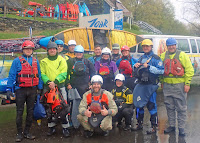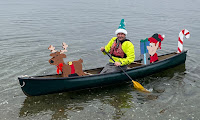 |
| Stokers on the Scantic |
My whitewater season started in February, and I got out on a lot of old favorites including Tville (1, 2), the Upper Millers (1, 2), Otter Brook, Knightville, Housatonic, Lower Deerfield, Pemi-Bristol, the Piscat, the Took and Crystal. I ran the Scantic Spring Splash whitewater race and was able to get into the swiftwater rescue class with the Boston AMC at Zoar Outdoors.
 |
| Swiftwater training with Boston AMC |
I led one Blackstone Valley Paddle Club trip - Rice City Pond, and three RICKA Flatwater trips – Providence, Point Judith Pond and the Lower Deerfield. I also coordinated the RICKA Flatwater Training.
 |
| Piscat surfing |
Here are some of my more significant trips:
I paddled almost every day of my summer vacation on Great Island including a RICKA trip on Point Judith Pond.
South County Vacation 2023 from Erik Eckilson on Vimeo.
In terms of resolutions for 2024, they are just like 2023.
- January - Providence, Willimantic
- February - Tville
- March - Scantic Spring Splash, Branch River Icebreaker
- April - Upper Millers, Otter Brook, Knightville
- May - Lackey Dam, Housatonic, West River, Potter Cover
- June - Pawcatuck River Overnight, Tville, Rice City Pond, Assabet
- July - Providence, Upper Millers, Point Judith Pond
- August - Lower Deerfield, Seekonk, Pemi – Bristol
- September - Charles, Allagash Wilderness Waterway
- October - Piscat
- November - Contoocook, Ware, Crystal
- December - Santa Paddle in Wickford, Winter Camping at Burlingame
South County Vacation 2023 from Erik Eckilson on Vimeo.
I did get out for a spring camping trip at Burlingame, and a fall Allagash trip with Jonathan, Conrad and Bob.
Allagash Camping 2023 from Erik Eckilson on Vimeo.
Allagash Camping 2023 from Erik Eckilson on Vimeo.
The year ended with a winter camping trip at Burlingame on New Year's Eve.
In terms of resolutions from last year, I did pretty well. I did take a training class in my sea kayak, I did a camping trip on the Allagash, and paddled quite a bit of whitewater. Unfortunately, I didn’t get my sea kayak out in rough water conditions, and I didn't make it back to the Dead.
 |
| Tandem paddling on the Took |
- Keep practicing with my new sea kayak – especially in rough water conditions.
- Keep camping – maybe the St. John, or the Allagash again. I’d still like to do a summer trip on the St. Croix, or the Maine Island Trail in my kayak.
- Keep paddling whitewater as long as my knee holds up.
- Get back to the Dead – always a great trip.
- Practice rolling – I’ll keep including it until I do it – maybe in the sea kayak.




















































